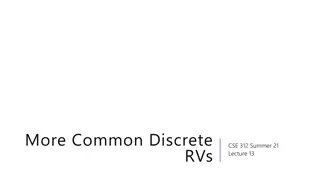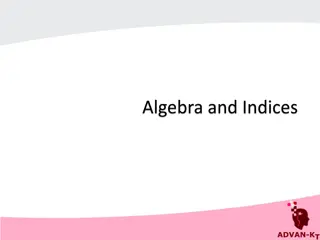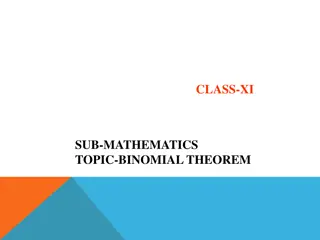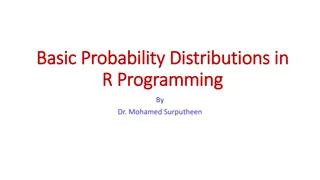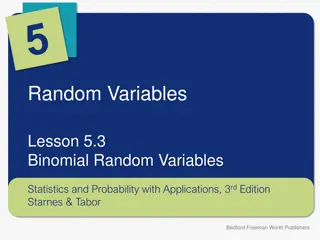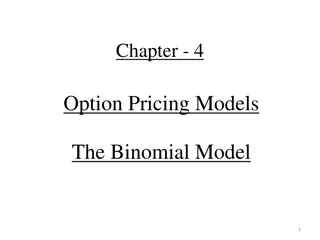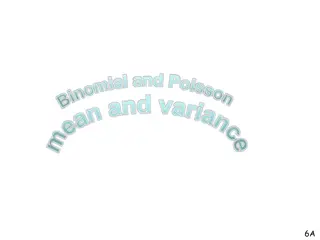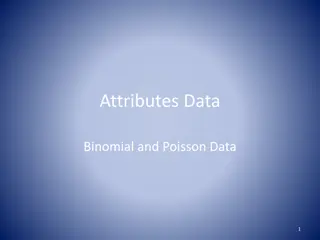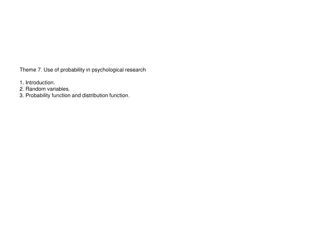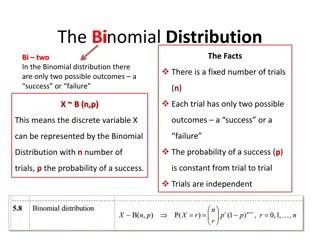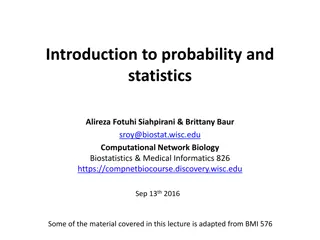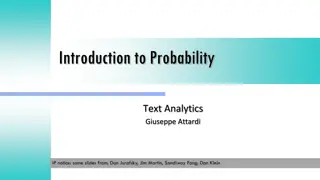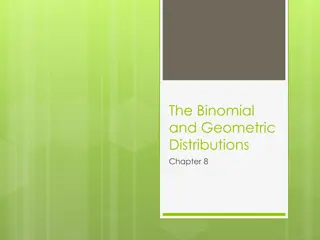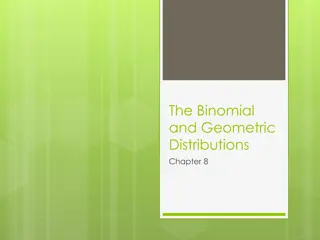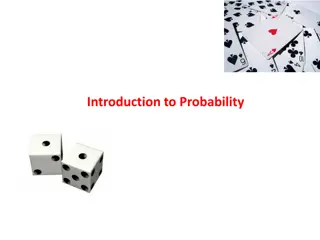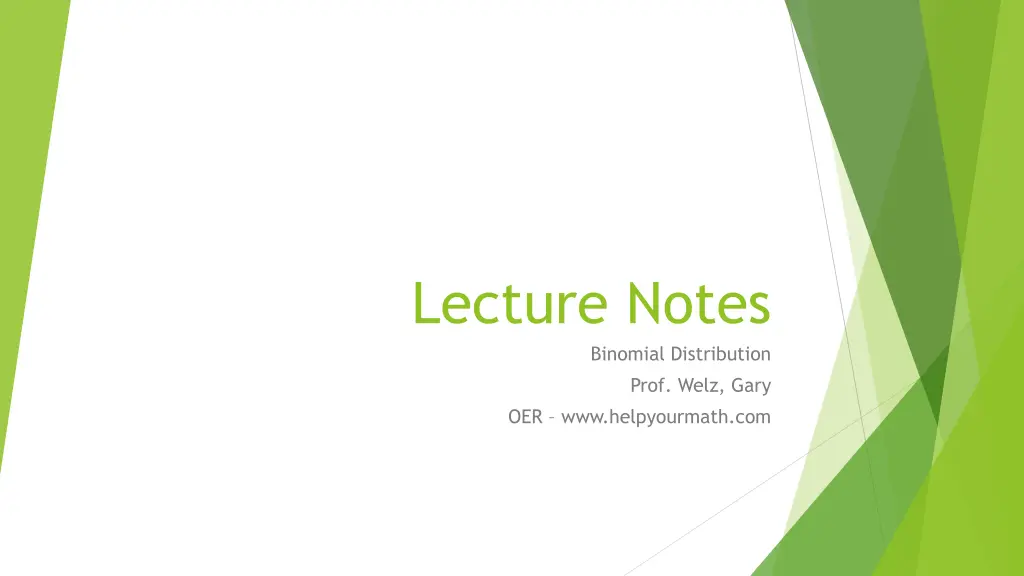
Understanding Binomial Distribution in Probability Theory
Learn about the binomial distribution in probability theory through examples like tossing coins and dice. Explore the formula, calculations, and possible outcomes to determine probabilities for various scenarios involving success and failure.
Download Presentation

Please find below an Image/Link to download the presentation.
The content on the website is provided AS IS for your information and personal use only. It may not be sold, licensed, or shared on other websites without obtaining consent from the author. If you encounter any issues during the download, it is possible that the publisher has removed the file from their server.
You are allowed to download the files provided on this website for personal or commercial use, subject to the condition that they are used lawfully. All files are the property of their respective owners.
The content on the website is provided AS IS for your information and personal use only. It may not be sold, licensed, or shared on other websites without obtaining consent from the author.
E N D
Presentation Transcript
Lecture Notes Binomial Distribution Prof. Welz, Gary OER www.helpyourmath.com
The Binomial Distribution When you toss dice or a coin the set of all outcomes has what we call a binomial distribution When each trial of an experiment, like tossing dice or coins, has exactly two possible outcomes, call them success and failure, then the probability of any combination of successes and failures can be represented by the following formula ? ? ????????? ?? ? ?????? ?? ? ???????? ?????????? = ? ?,? (??)(1 ?)? ? Sometimes written as ???(??)(1 ?)? ? Where ? ?,? or represents the probability of success on a single trial and 1-p represents its compliment, i.e. probability of failure on a single trial. ???represent the number of combinations of n things taken x at a time, p
Example 1: Exactly 2 heads in 3 tosses What is the probability of tossing a coin three times and getting exactly two heads? If we consider getting a head to be success, then getting a tail is failure. We let n=3 and x=2 because we are tossing the coin three times and getting exactly two heads. The number of combinations of 3 things taken 2 at a time is given by the formula ?! ? ? ! ?!= Since heads and tails are equally likely, p=0.5 and 1-p=1-0.5=0.5 3! 6 3 2 ! 2!= 1 2= 3
Example 1: Exactly 2 heads in 3 tosses continued So the entire calculation becomes: 3 (0.5)2 (0.5)3 2 = 3 (0.5)2 (0.5)1 = 3 (0.25) (0.5) = 0.375 Or, using fractions 3 (1 4) (1 2)= 3 8
How many possible outcomes are there? The 4 possible outcomes are: 1. 0 heads and 3 tails 2. 1 head and 2 tails 3. 2 heads and 1 tail 4. 3 heads and 0 tails
Example 2: Exactly 0 heads in 3 tosses Here s another case. What is the probability of tossing a coin three time and getting zero heads? Again, we consider getting a head to be success and getting a tail is failure. We let n=3 and x=0 because we are tossing the coin three times and getting exactly two heads. The number of combinations of 3 things taken 0 at a time is given be the formula ?! ? ? ! ?!= Remember, 0! Is defined to be equal to 1. 3! 6 3 0 ! 0!= 6 1= 1
Example 2: Exactly 0 heads in 3 tosses continued So the entire calculation becomes: 1 (0.5)0 (0.5)3 0 = 1 (0.5)0 (0.5)3 = 1 (1) (0.125) = 0.125 Or, using fractions 1 (1) (1 8)= 1 8
Probability Distribution for Tossing 3 coins Number of heads Probability 0 1/8 or 0.125 = 12.5% 1 3/8 or 0.375 = 37.5% 2 3/8 or 0.375 = 37.5% 3 1/8 or 0.125 = 12.5%
Histogram for the Binomial Distribution of tossing 3 coins. Probability Distribution for 3 coin tosses 0.400 0.350 0.300 0.250 0.200 0.150 0.100 0.050 0.000 Probability 0 heads 1 head 2 heads 3 heads
What about getting at least or at most a certain number of heads? We can think of getting At least two heads in three tosses as equivalent to getting exactly two heads or exactly three heads. To calculate these probabilities you simply calculate the probability of each of the possible alternatives and add them together. For example P(At least two heads in three tosses) = P(Exactly 2 heads in three tosses) + P(Exactly 3 heads in three tosses) =3 2= 0.5 Similarly, At most two heads in three tosses would be equivalent to getting zero heads, one head or two heads. 8+1 8=1 P(At most two heads in three tosses) = P(Exactly 0 heads in 3) + P(Exactly 1 head in 3) + P(Exactly 2 heads in 3) =1 8= 0.875 8+3 8+3 8=7
What about when success and failure are not equally likely? When we toss a 6-sided die, the probability of any one of the six faces showing up is 1 the probability of failure, denoted by 1-p, would be 1-(1 6. So the value of the probability of success, p would be 1 6, but 6) = 5 6. Consequently, the probability of getting exactly one #1 (or any other single number) when you roll a die two times would be. = ? 2,1 (1 6)1 (5 6) (5 6)2 1 2 1 ! 1! (1 =2 (5 2! = 6) 36) = 10 36= 5 18


